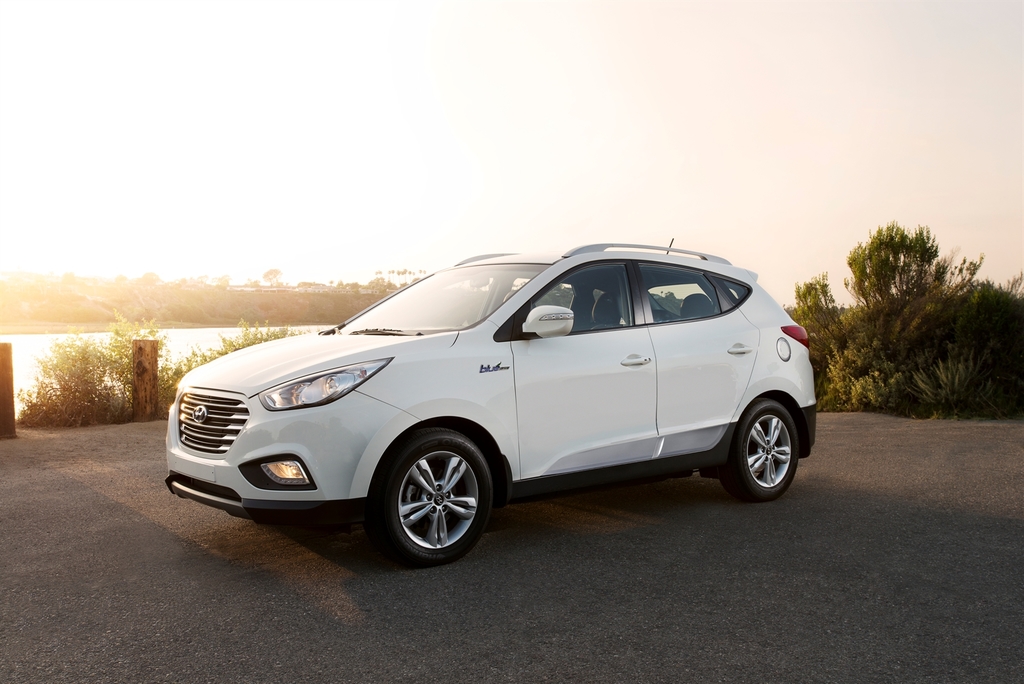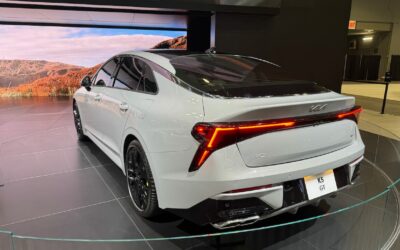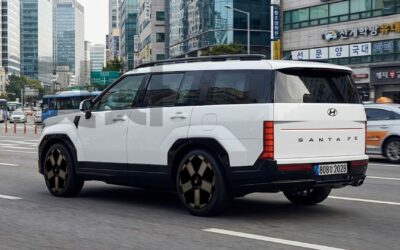Hyundai is witnessing exceptionally strong consumer interest in its next-generation Tucson Fuel Cell CUV, with more than 88,000 unique visitors to its Hyundai.com fuel cell microsite since the program’s November introduction. Consumers selected for the program can drive the Tucson Fuel Cell for just $499 per month, which includes unlimited free hydrogen refueling and “At Your Service” valet maintenance at no extra cost. For the first time, retail consumers will be able to put a federally-certified hydrogen fuel cell vehicle in their driveways, with availability beginning in late Spring 2014 at select Southern California Hyundai dealers.
[ads id=”0″ style=”float:left;padding:5px;”] “We’re experiencing strong consumer interest to drive the Tucson Fuel Cell CUV,” said Michael O’Brien, vice president, corporate and product planning, Hyundai Motor America. “Hydrogen-powered fuel cell vehicles represent the next generation of zero-emission vehicle technology, and we intend to be a leader in offering the mass-produced, federally-certified Tucson Fuel Cell to retail customers. The range and refueling speed of our Tucson Fuel Cell is superior to the range and charging limitations of competing battery electric vehicles. Even more, fuel cell technology is sure to increase the adoption rate of zero-emission vehicles, and everyone will receive the environmental benefits.”
FUEL CELL PRICING AND BENEFITS
The Hyundai Tucson Fuel Cell will initially be offered to customers in the Los Angeles/Orange County region for $499 per month for a 36-month term, with $2,999 down. This includes the addition of a remarkable new addition to the Hyundai Assurance program –unlimited free hydrogen refueling. “When we spoke to customers interested in driving a hydrogen fuel cell vehicle, many wondered what the cost of hydrogen would be,” said John Krafcik. To ease those concerns as we build-out the hydrogen refueling network, we thought covering this cost for these early adopters in the monthly payment was the best approach, and consistent with other aspects of our Hyundai Assurance program. It’s our way of saying: ‘This is another thing you don’t have to worry about, we’ve got your back.’”
In addition, Tucson Fuel Cell owners will enjoy all the same services of the Hyundai Equus “At Your Service” valet program. As Equus owners have enjoyed since its introduction in 2010, should a Tucson Fuel Cell require any service, a Hyundai dealer will pick up the vehicle and provide a loaner, then return their car after service to their home or business, at no charge.
Customers interested in the Tucson Fuel Cell can indicate their interest (the first step in the ordering process) beginning today by visiting Hyundai.com.
The first four Hyundai dealers to offer the Tucson Fuel Cell to Southern California customers are Hardin Hyundai in Anaheim, Win Hyundai in Carson, Keyes Hyundai in Van Nuys and Tustin Hyundai, with additional Hyundai dealers to follow. Availability of the Tucson Fuel Cell will expand to other regions of the country consistent with the accelerating deployment of hydrogen refueling stations.
THE NEXT-GENERATION ELECTRIC VEHICLE
To achieve societal goals of significant reduction in greenhouse gas emissions, more and more consumers will need to drive zero-emissions vehicles. Currently, there’s an ongoing debate about the future of the electric vehicle, with two schools of thought:
- Store more electricity on-board using more/larger batteries
- Create electricity on-board with hydrogen-powered fuel cell technology
Developed over 100 years ago, the battery electric vehicle has made progress in recent years, with improved affordability and energy storage capability. But for most consumers, range anxiety and lengthy recharging time remain formidable obstacles to using them in their daily lives. In addition, affordable electric vehicle technology is best suited to smaller urban vehicles, not larger family and utility vehicles that many families require to meet all of their needs. Because of the inherent weight and cost of batteries, and the chemistry and physics that drive slow recharge times, today’s electric vehicles have practical limits for many consumers.
[ads id=”0″ style=”float:left;padding:0px;”]TUCSON FUEL CELL ADVANTAGES
Hyundai is introducing its Tucson Fuel Cell to alleviate the limitations of traditional battery electric vehicles. The Tucson Fuel Cell maintains the day-to-day flexibility of the gasoline-powered Tucson so that its driver is able to immediately enjoy the next generation of electric vehicles without range or recharge-time compromises to their lifestyle.
The Tucson Fuel Cell represents the next generation of electric vehicles – those that create their own electricity, on-board, from hydrogen. According to UCI’s Advanced Power and Energy Program’s 2013 study, the hydrogen fuel cell provides lower total well-to-wheel emissions than a battery electric vehicle. For the Tucson Fuel Cell driver, this social benefit is achieved with greater utility, versatility and without compromises. Consider:
- Driving range up to 300 miles*
- Capable of full refueling in under 10 minutes, similar to gasoline
- Minimal reduction in daily utility compared with its gasoline counterpart
- Instantaneous electric motor torque (221 lb-ft)
- Minimal cold-weather effects compared with battery electric vehicles
- Superb daily reliability and long-term durability
- No moving parts within the power-generating fuel cell stack
- More than two million durability test miles on Hyundai’s fuel cell fleet since 2000
- Extensive crash, fire and leak testing successfully completed
- Quieter EV operation
- Zero greenhouse-gas emissions, emits only water vapor
* Estimated driving range based on internal tests; EPA ratings to be determined by launch
The Tucson Fuel Cell begins mass production for the U.S. market in February 2014 at the Ulsan, Korea assembly plant that also manufactures the Tucson gasoline-powered CUV. Manufacturing the Tucson Fuel Cell at the same plant allows Hyundai to leverage both the high quality and cost-efficiency of its popular gasoline-powered Tucson platform.
HYDROGEN RENEWABLE ENERGY SOLUTIONS
The benefits of hydrogen are well known — required supplies for the U.S. market can be produced domestically and its supply is virtually unlimited. It can be produced by varied means – including renewable sources such as biogas. In fact, Hyundai’s Fuel Cell prototypes have relied on hydrogen generated at the Orange County Sanitation District near its Fountain Valley headquarters, where methane from sewage is turned into hydrogen. Hydrogen can even be sourced directly from water, using electrolysis to split hydrogen molecules with electricity from renewable sources such as wind and solar.
Further supporting hydrogen infrastructure development, California approved a plan in October 2013 to develop up to 100 hydrogen refueling stations in the state over the next several years. This recent California initiative dovetails with increased government support of hydrogen infrastructure development at the federal level, such as H2USA.
HYDROGEN: LOWEST WELL-TO-WHEEL EMISSIONS
According to 2013 studies on well-to-wheel greenhouse-gas emissions (GHG) by the Advanced Power and Energy Program at the University of California, Irvine, hydrogen-powered fuel cell vehicles have the lowest overall emission levels of all alternative fuel entries. Well-to-wheel emissions for hydrogen vehicles sourced from natural gas are lower than battery electric vehicles, and less than half of equivalent gasoline vehicle emissions. Even more impressive, hydrogen emissions sourced from biogas are a tiny fraction of equivalent gasoline vehicle emissions, yielding an extremely high factor of long-range emissions sustainability.
FUEL CELL TECHNOLOGY: HOW IT WORKS
Hyundai’s fuel cell effectively replaces the battery pack used in an electric vehicle by generating electricity from hydrogen through an electrochemical process that does not involve hydrogen combustion, with no moving parts within the fuel cell stack.
The fuel cell electrochemical process is as follows:
- Hydrogen enters the anode, air (oxygen) enters the cathode
- Catalyst splits the hydrogen electrons and protons
- Electrolyte conducts the positively-charged ions while blocking the electrons
- Electrons are used to create an external circuit, generating electricity
- Catalyst combines the hydrogen ions and electrons with oxygen to create water and heat energy
- A single fuel cell produces approximately one volt; fuel cells are “stacked” to meet voltage requirements
ENTERPRISE RENT-A-CAR EVALUATION DRIVE AVAILABILITY
Hyundai is also partnering with Enterprise Rent-A-Car to make the Tucson Fuel Cell available to consumers at select locations in the Los Angeles/Orange County region. This partnership will enable interested consumers to evaluate the Tucson Fuel Cell for their lifestyles on a multi-day basis, with rental availability also planned for Spring 2014.








